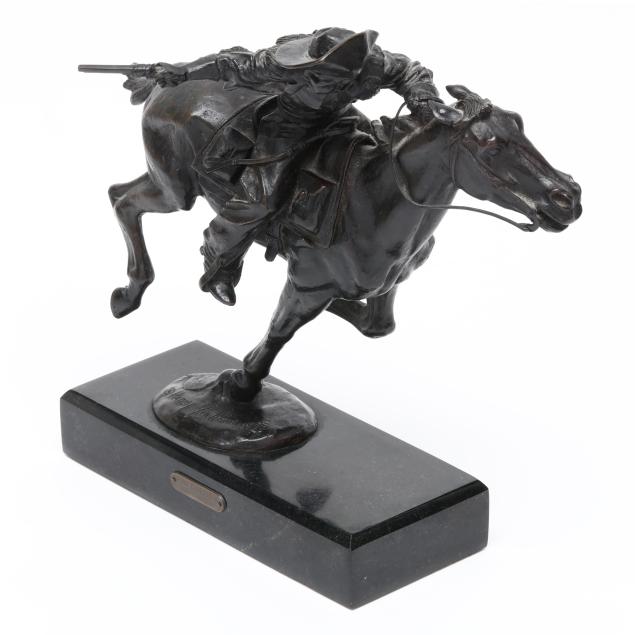
Lot 6049
Harry Andrew Jackson (American, 1924-2011), Pony Express III
Explore more items like this one.
Visit our Fine Art Department Fine Art
Lot Details & Additional Photographs
10 x 10 x 6 1/2 in.
Private Collection, California and North Carolina
Sculptor Harry Jackson was primarily known for bronze works of western theme. Born "Harry Shapiro" on the south side of Chicago, at age 14, Harry ran away from home to Wyoming where he worked at a lumber company and on a ranch. These formative experiences would be part of the impetus behind his sculptural ouvre of western theme subjects.
In the late 1930s, Harry returned to Chicago and studied at the Frederick Mizen Academy, The Chicago Academy of Fine Arts, and The Chicago Art Institute. In 1942, he entered the Marine Corp. Following his discharge after being wounded in Pacific service, he received a Purple Heart. He worked as a radio actor and went to New York and formed a friendship with abstract artist, Jackson Pollock. The two formed a lasting friendship, and Pollock introduced Jackson to Abstract Expressionism. He quickly gained notice after Meyer Schapiro and Clement Greenberg included him in their "Talent 1950" exhibition at the Kootz Gallery, and over the next several years he exhibited at Tibor de Nagy, a nerve center of second-generation Abstract Expressionism.
In 1954, Harry had a brief marriage to the American abstract artist Grace Hartigan , his first of six wives, and reportedly at Pollock's home with Pollock serving as best man. He also took classes at the Brooklyn Museum and studied with Rufino Tamayo and Hans Hofmann.
After traveling to Italy in the early 1950s, he re-embraced realism and undertook a journey that Life magazine chronicled in an extensive 1956 photo essay, "Painter Striving to Find Himself: Harry Jackson Turns to the Hard Way." These years encouraged his return to the subject matter that had captured his imagination as a boy, the West, he produced works such as "The Stampede" and "The Range Burial," as well as many others works depicting prairie life.
His works are held by major museums such as the Buffalo Bill Museum, Glenbow Foundation (Calgary), Montana Historical Society, Whitney Gallery of Western Art, Wyoming State Gallery, Woolaroc Museum and the Fort Pitt Museum.
Good estate condition.









